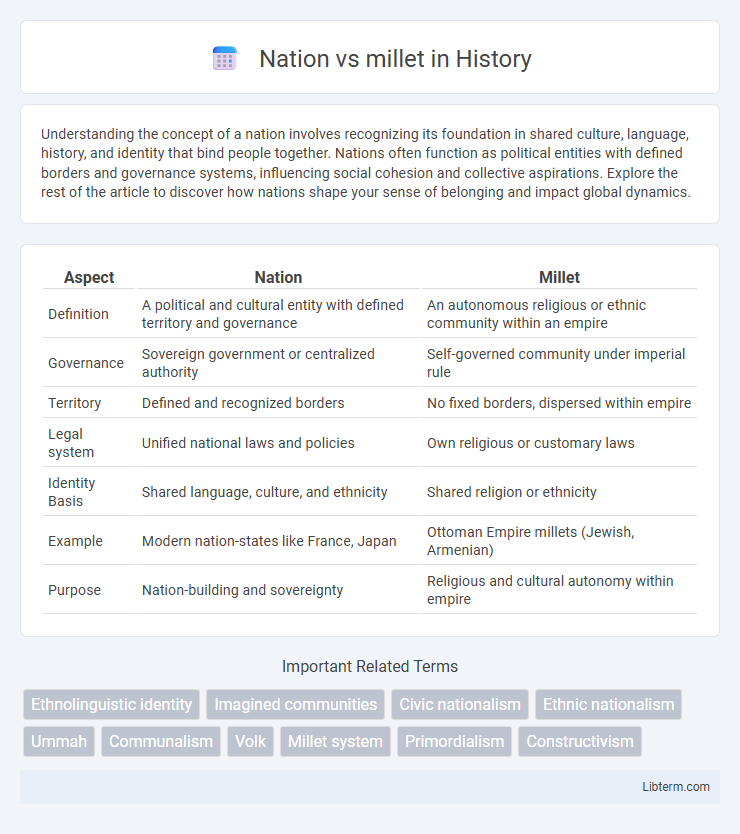Understanding the concept of a nation involves recognizing its foundation in shared culture, language, history, and identity that bind people together. Nations often function as political entities with defined borders and governance systems, influencing social cohesion and collective aspirations. Explore the rest of the article to discover how nations shape your sense of belonging and impact global dynamics.
Table of Comparison
| Aspect | Nation | Millet |
|---|---|---|
| Definition | A political and cultural entity with defined territory and governance | An autonomous religious or ethnic community within an empire |
| Governance | Sovereign government or centralized authority | Self-governed community under imperial rule |
| Territory | Defined and recognized borders | No fixed borders, dispersed within empire |
| Legal system | Unified national laws and policies | Own religious or customary laws |
| Identity Basis | Shared language, culture, and ethnicity | Shared religion or ethnicity |
| Example | Modern nation-states like France, Japan | Ottoman Empire millets (Jewish, Armenian) |
| Purpose | Nation-building and sovereignty | Religious and cultural autonomy within empire |
Defining Nation and Millet: Key Differences
A nation is a large group of people united by shared culture, language, history, and often a defined territory, emphasizing political and social cohesion. A millet refers to a smaller, religious or ethnic community within a larger empire or state, possessing limited self-governance primarily in personal law and religious matters. The key differences lie in the scope of identity and governance: nations prioritize collective sovereignty and cultural unity, while millets function as autonomously administered subgroups under overarching political authority.
Historical Origins of Nation and Millet Systems
The historical origins of the nation system trace back to the Treaty of Westphalia in 1648, which established sovereign states based on defined territorial boundaries and centralized governance. In contrast, the millet system emerged during the Ottoman Empire as a method for managing diverse religious and ethnic communities by granting them autonomous legal and administrative authority under their own leaders. These systems represent distinct approaches to political organization: nations emphasize territorial sovereignty and uniform laws, while millets prioritize communal autonomy within a multicultural empire.
The Millet System in the Ottoman Empire
The Millet system in the Ottoman Empire was an administrative framework that organized diverse religious communities into semi-autonomous groups under their own religious leaders. Each millet managed its own legal affairs, education, and religious practices, allowing a degree of cultural and religious self-governance while remaining loyal to the Ottoman state. This system contrasted with the modern concept of a nation-state by prioritizing religious identity over ethnic or national identity in governance and community organization.
Emergence of Modern Nation-States
The emergence of modern nation-states transformed the millet system, which organized diverse religious communities within the Ottoman Empire, into centralized political entities defined by territorial sovereignty and uniform citizenship laws. Nation-states prioritized ethnic and linguistic unity, replacing the millet's religious autonomy with national identity, legal codification, and centralized governance. This shift restructured political boundaries and social organization, fostering nationalism while diminishing the millet's traditional communal authority.
National Identity vs. Communal Identity
National identity is shaped by shared language, culture, history, and political institutions that unify a population under a sovereign state, fostering a cohesive sense of belonging and citizenship. In contrast, millet systems emphasize communal identity through religious or ethnic self-governance within a larger empire, allowing distinct groups to maintain their own legal and social frameworks. The tension between national identity and communal millet identity highlights the challenges in balancing collective unity with pluralistic diversity in multi-ethnic societies.
Religion and Ethnicity in Nation and Millet Structures
Nation structures often blend ethnicity and religion to create a unified national identity, emphasizing shared cultural heritage and common beliefs. Millet systems distinctly organize communities primarily by religion rather than ethnicity, granting religious groups legal autonomy within an empire or state. While nations integrate multiple ethnicities under a singular civic identity, millets maintain separate religious communities with their own legal and social frameworks.
Governance Models: Centralized vs. Autonomous
Nations typically operate under centralized governance models where a single authority enforces uniform laws and policies across the entire territory, ensuring national unity and standardized administrative control. Millets, historically referring to autonomous religious or ethnic communities within larger empires like the Ottoman Empire, functioned with self-governance, managing their own legal, educational, and social affairs independently. This distinction highlights how nations prioritize centralized political integration, while millets emphasize decentralized, community-based autonomy within a broader state framework.
Social Cohesion and Division: Impacts on Society
The distinction between nation and millet systems significantly affects social cohesion, where nations emphasize a unified identity based on shared language, culture, and territory, promoting social integration. In contrast, millet systems institutionalize religious or ethnic communities as separate autonomous groups, which can lead to social segmentation and limited cross-community interaction. This division often entrenches communal identities, potentially intensifying social fragmentation and hindering broader societal unity.
Transition from Millet to Nation-State in History
The transition from millet systems to modern nation-states marked a significant shift in political and social organization, particularly in the Ottoman Empire and the Balkans during the 19th and early 20th centuries. Millet, defined as religious communal groups with autonomous legal and educational authority, gradually gave way to nationalist movements emphasizing ethnic identity and centralized state sovereignty. This transformation was driven by the rise of nationalism, weakened imperial control, and the influence of European state models, culminating in the establishment of nation-states with unified administrative structures and defined territorial boundaries.
Contemporary Relevance: Lessons for Today
The distinction between nation and millet systems highlights the importance of recognizing diverse cultural and religious identities within modern states, as seen in contemporary multiethnic countries like India and Lebanon. Understanding millet frameworks offers valuable insights for managing minority rights and fostering social cohesion without enforcing assimilation. This historical experience informs policies promoting inclusive governance, protecting cultural autonomy, and preventing ethnoreligious conflicts in today's pluralistic societies.
Nation Infographic

 libterm.com
libterm.com